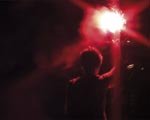Jocelyn Cottencin
dal 25/1/2007 al 10/3/2007
Segnalato da
25/1/2007
Jocelyn Cottencin
La Criee Centre for Contemporary Art, Rennes
Just a Walk. His artistic practice associates photography, video, installation and graphic design. Because of this, the work shown may seem very diverse, however rather than an installation of a group of works, what the project invites the visitor to discover is the relations that make up a coherent space for reflection with its own specific temporality. The practice of displacement, with the connections it creates between ideas, individuals, artworks and structures, tests the notion of "territories".

Just a Walk
In 2005, la criee center for contemporary art initiated a program of European
residencies in the cities of the Atlantic Arc. Just a Walk is a project created by
the artist and graphic designer Jocelyn Cottencin that began in March 2005 and will
continue its development through January 2007 between Bilbao, San Sebastian,
Glasgow, Porto, Lisbon and Rennes. The project involves an Internet site, periods
spent in residency, work sessions between artists and art professionals, and an
exhibition.
Just a Walk is not in itself a direct questioning of European space, however the
practice of displacement, with the connections it creates between ideas,
individuals, artworks and structures, tests the notion of "territories".
This notion must be considered at once in terms of its geographic reality and the
imaginary and utopian dimension it generates, the relationship the individual
constructs with her environment, a nation, an identity, a private or shared space.
Jocelyn Cottencin's artistic practice associates photography, video, installation
and graphic design. Because of this, the work shown at la criee may seem very
diverse, however rather than an installation of a group of works, what Just a Walk
invites the visitor to discover is the relations that make up a coherent space for
reflection with its own specific temporality. Here, images are not simply to be seen
but to be experimented with in an environment of waiting, suspension or latency.
Just a Walk creates a space dedicated for the ramifications of visual resonances.
Like the hyperlinks of the Internet site where the exchanges of the artists
participating in the residencies appear, the works presented in the exhibition refer
back to and illuminate one another (in both the literal and metaphorical sense since
they produce their own light). They function by stratification, circumvolution,
dispersion or reassembly and offer multiple possible readings that one can make
one's own for as many different discoveries of the same project.
Videos show scenes of human crowds and urban masses that at first seem easily
identifiable but little by little uncertainty sets in. The contact that takes place
between individuals - exchanges, frictions, encounters, avoidance - may influence
our perception of their environment, unless it is the environment that gives new
meaning to their behaviour.
Views of natural sites, void of human presence, are displayed in large-format
photographs and videos. Subtle details, such as variations in light, relief or
atmospheric conditions, cause these spaces to take on an enigmatic presence.
Sentences written directly on the wall or in neon lettering are revealed through a
font that proliferates until it becomes itself landscape. The graphics are in
resonance with the meaning of the proposition, since Jocelyn Cottencin’s work as a
graphic designer is indissociable from his artistic practice.
In other photographs, our attention focuses on beings engaged in concrete physical
actions such as walking, or, on the contrary, lost in thought, unconscious of their
bodies. The actions here are not defined in terms of their purpose (the possibility
of a narrative is left to the viewer) but rather in terms of flux and rhythms.
At the heart of Jocelyn Cottencin's creative process is an abandonment of control
over the gaze in order to attempt to create images that contain something other than
what they show us: another place, a different temporality…
Beyond the contemplation they originally provoke, Jocelyn Cottencin's works escape
us. Often imposing but never spectacular, they leave room for doubt and uncertain
perception. Through these unstable situations, through the slowness of a movement,
the roundness of a form, a critical position emerges that resists all forms of
facile seduction, and all claims to authoritarian truth.
Opening Friday, 26 January, 6:00 p.m. at the CCNRB / 7:00 p.m. at la criee
La Criee - Center for Contemporary Art
place Honore' Commeurec - Rennes
Admission free
Tuesday to Friday from 12 p.m. to 7 p.m.; Saturday and Sunday from 2:00 p.m. to 7 p.m.



